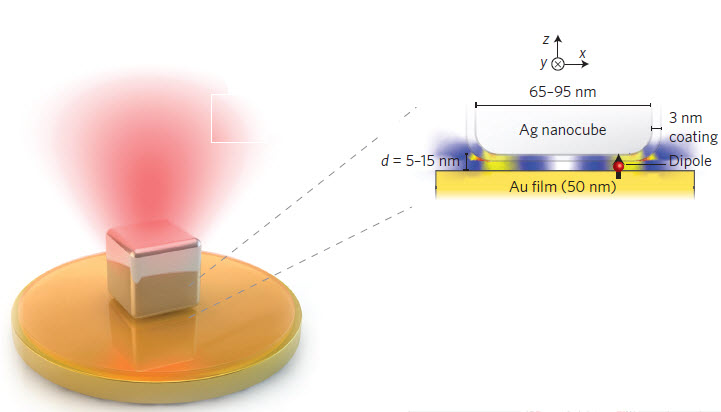High-speed fluorescence for 1,000-times-faster LEDs
October 13, 2014
 Duke University researchers have made fluorescent molecules emit photons of light 1,000 times faster than with previous designs — a speed record, and a step toward realizing superfast light-emitting diodes (LEDs) for nanophotonic devices, such as telecommunication lasers and as single-photon sources for quantum cryptography.
Duke University researchers have made fluorescent molecules emit photons of light 1,000 times faster than with previous designs — a speed record, and a step toward realizing superfast light-emitting diodes (LEDs) for nanophotonic devices, such as telecommunication lasers and as single-photon sources for quantum cryptography.
The 2014 Nobel Prize in Physics was awarded for the discovery 20 years ago of how to make blue LEDs, leading to more efficient white light bulbs and video screens. But LEDs’ slow emission rate (∼10 nanoseconds) and non-directional emission has limited their use.
Now in a new study, engineers from Duke headed by Maiken Mikkelsen, an assistant professor of electrical and computer engineering and physics, significantly increased the photon emission rate of fluorescent molecules. The results appear online October 12 in Nature Photonics.
How it works
When fluorescent molecules are placed near intensified light, the molecules emit photons at a faster rate, through an effect called Purcell enhancement.
In the experiment, Mikkelsen’s group created a plasmonic* patch antenna using two 75-nanometer-wide silver nanocubes, and trapped light between them, greatly increasing the light’s intensity.
The researchers also found they could achieve a significant speed improvement by placing fluorescent molecules in the vertical dielectic (insulating gap) between the nanocubes and a thin film of gold.

Schematic of a silver nanocube situated on a gold film separated by a 5–15 nm spacer layer containing a fluorescent material. The red cone indicates the directionality of the enhanced emission originating from the vertical nanogap region. (Image adapted.) (Credit: Gleb M. Akselrod et al./Nature Photonics)
To attain the greatest effect, Mikkelsen’s team tuned the gap’s resonant frequency to match the color of light that the molecules respond to (in a range from green to infrared). With the help of co-author David R. Smith, the James B. Duke Professor and Chair of Electrical and Computer Engineering at Duke, they used computer simulations to determine the exact size of the gap needed between the nanocubes and gold film to optimize the setup, which turned out to be 20 nanometers.
“We can select cubes with just the right size and make the gaps with nanometer precision,” said Gleb Akselrod, a postdoc in Mikkelsen’s lab and first author on the study. “When we have the cube size and gap perfectly calibrated to the molecule, that’s when we see the record 1,000-fold increase in fluorescence speed.”
Because the experiment used many randomly aligned molecules, the researchers believe they can do even better. They plan to design a system with individual fluorescent molecule placed precisely underneath a single nanocube. According to Akselrod, they can achieve even higher fluorescence rates by standing the molecules up on edge at the corners of the cube.
“If we can precisely place molecules like this, it could be used in many more applications than just fast LEDs,” said Akselrod. “We could also make fast sources of single photons that could be used for quantum cryptography. This technology would allow immediate communications across vast distances that could not be hacked.”
This work was supported by the Lord Foundation of North Carolina and the Air Force Office of Scientific Research (Contract No. FA9550-09-1-0562).
* The interaction between electromagnetic fields and free electrons in metal, generating light.